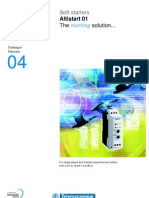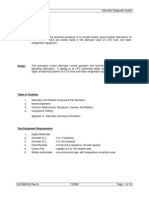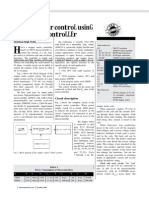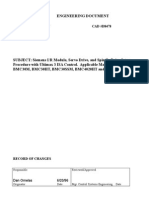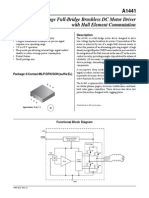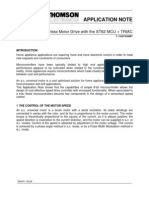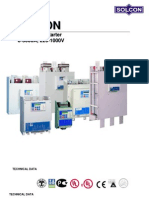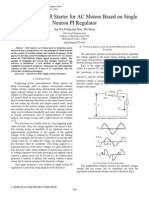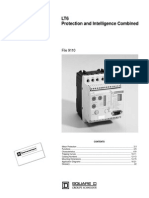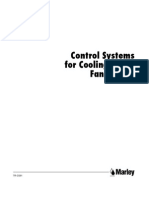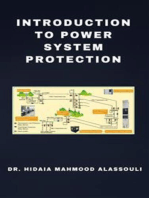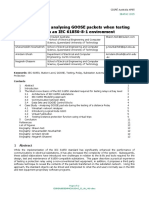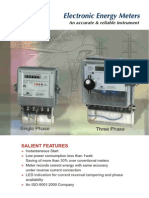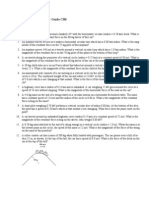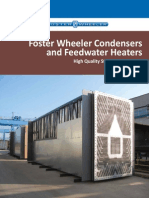Altistart Soft Start-Stop Units
Altistart Soft Start-Stop Units
Uploaded by
steve_osullivanCopyright:
Available Formats
Altistart Soft Start-Stop Units
Altistart Soft Start-Stop Units
Uploaded by
steve_osullivanOriginal Description:
Original Title
Copyright
Available Formats
Share this document
Did you find this document useful?
Is this content inappropriate?
Copyright:
Available Formats
Altistart Soft Start-Stop Units
Altistart Soft Start-Stop Units
Uploaded by
steve_osullivanCopyright:
Available Formats
7
Te
Soft start units
Altistart soft start-stop units
Contents
Torque and current curves pages 8 to 11
Presentation, description page 12
Operation pages 13 to 15
Characteristics pages 16 and 19
References pages 20 to 23
Options
Dialogue and communication pages 24 to 26
Line chokes page 27
Dimensions pages 28
Schemes pages 30 to 33
Compatibility pages 34 and 35
Spare parts pages 36 and 37
8
Te
Soft start units
Conventional starting of 3-phase asynchronous motors
Torque and current curves
Direct on line starting
i Starting current
4 to 8 times the nominal current.
i Starting torque
0.5 to 1.5 times the nominal torque.
i Characteristics
- 3-terminal motor, low to medium power.
- On-load starting.
- High starting current peak and voltage drop
- Simple equipment.
i No parameter adjustment.
Star-delta starting
i Starting current
1.8 to 2.6 times the nominal current.
i Starting torque
0.5 times the nominal torque.
i Characteristics
- 6-terminal motor.
- No-load starting or starting with low resistive torque.
- High current and torque peaks at "star-delta"
changeover.
- Equipment requires maintenance.
i No parameter adjustment
Presentation, description :
page 12
Characteristics :
pages 16 to 19
References :
pages 20 to 27
Dimensions :
pages 28 and 29
6
5
4
3
2
1
0
0 0,25 0,5 0,75 1
N/Ns
I/In
2,5
2
3
1,5
1
0,5
0
0 0,25 0,5 0,75 1
N/Ns
C/Cn
Cr
6
5
4
3
2
1
0
0 0,25 0,5
0,75 1
N/Ns
I/In
2,5
2
3
1,5
1
0,5
0
0 0,25 0,5 0,75 1
N/Ns
C/Cn
Cr
T/Tn
T/Tn
Tr
Tr
9
Te
Soft start units
Conventional starting of 3-phase asynchronous motors
Torque and current curves
Primary resistance starting
i Starting current
4.5 times the nominal current.
i Starting torque
0.5 to 0.75 times the nominal torque.
i Characteristics
- 3-terminal, high power motor.
- Increasing resistive torque during starting.
- High current peak.
- Bulky equipment, which requires maintenance.
i No parameter adjustment.
T/Tn
Autotransformer starting
i Starting current
1.7 to 4 times the nominal current.
i Starting torque
0.4 to 0.85 times the nominal torque.
i Characteristics
- 3-terminal, high power motor.
- Large voltage drop and high current peak when starting
at the instant of transition.
- Bulky, complex equipment, requiring maintenance.
i No parameter adjustment.
Presentation, description :
page 12
Characteristics :
pages 16 to 19
References :
pages 20 to 27
Dimensions :
pages 28 and 29:
6
5
4
3
2
1
0
0 0,25 0,5 0,75 1
N/Ns
I/In
2,5
2
3
1,5
1
0,5
0
0 0,25 0,5 0,75 1
N/Ns
C/Cn
Cr
6
5
4
3
2
1
0
0 0,25 0,5 0,75 1
N/Ns
I/In
2,5
3
2
1,5
1
0,5
0
0 0,25 0,5 0,75 1
N/Ns
C/Cn
Cr
T/Tn
T/Tn
Tr
Tr
Te 10
0
0 0,25 0,5 0,75 1
N/Ns
Cr
U
0,85 U
0,6 U
C
0
0 0,25 0,5 0,75 1
N/Ns
Cr
Cd1
Cd
Id1
Id
3
M
T
Is
Td1
Soft start units
Soft-starting 3-phase asynchronous motors
Torque and current curves
Electronic starting by varying the voltage and the current limit
The voltage of the 3-phase supply to the motor is steadily increased by the use of a thyristor bridge. The bridge consists
of back to back pairs of thyristors connected in each phase of the a.c. supply.
By varying the firing angle of the thyristors, the motor can be fed with a steadily increased voltage at fixed frequency.
The output voltage can be controlled either by an acceleration ramp or by the current limit or by a combination of both
parameters.
Is
Figure 1 illustrates the development of the torque as a
function of the starting current.
Limiting the starting current ls to a present value ls1 has the
effect of reducing the starting torque Ts1 which is practi-
cally equal to the ratio of the square of currents ls and ls1.
Example :
For a motor with Ts = 2 Tn for ls = 6 ln, limiting the current
to ls1 = 3 ln, or 0.5 ls, gives a starting torque :
Ts1 = Ts x (0.5)
2
= 2 Tn x 0.25 = 0.5 Tn.
Figure 1
Figure 2 illustrates the torque/speed characteristic of a
squirrel cage motor as a function of the supply voltage.
At fixed frequency the torque varies as the square of the
voltage. The steady rise of the voltage limits the torque and
the current during starting, and prevents instantaneous
current peaks.
Figure 2
Tr
Ts1
Is1
Ts
Tr
Presentation, description :
page 12
Characteristics :
pages 16 to 19
References :
pages 20 to 27
Dimensions :
pages 28 and 29
11
Te
Soft start units
Soft-starting 3-phase asynchronous motors
Torque and current curves
Soft-starting using the Altistart 46 (torque control)
Altistart 46 is a 6-thyristor soft start - soft stop unit for the controlled starting and stopping of 3-phase asynchronous squirrel
cage motors.
It provides :
i control of the operating characteristics, during starting and stopping periods,
i thermal overload protection of both the motor and the starter,
i mechanical protection of the driven machine, by the elimination of torque surges and reduction of the inrush current,
i control of accelerating torque in all of zone 1 for true control of starting phases,
i adaptation of motor torque profile to the application,
i reduction of losses in the motor.
i Starting current
Adjustable from 2 to 5 times the nominal current.
i Starting torque
Variable from 0.15 nominal torque to nominal torque.
i Characteristics
- 3-terminal motor, nominal 2.2 to 800 kW,
- Independently adjustable acceleration and
deceleration ramps.
- d.c. injection braking possible.
- Equipment needs no maintenance.
Note: Altistart 46 soft start units are motor starters.
They cannot be used to supply resistors or transformers.
Presentation, description :
page 12
Characteristics :
pages 16 to 19
References :
pages 20 to 27
Dimensions :
pages 28 and 29
6
5
4
3
2
1
0
0 0,25 0,5 0,75 1
N/Ns
I/In
2,5
2
3
1,5
1
1
0,5
0
0 0,25 0,5 0,75 1
N/Ns
Cr
C/Cn
T/Tn
Tr
12
Te
Soft start units
Altistart 46 soft start - soft stop units
Presentation, description
Presentation
All the dialogue functions are accessible on the front panel
of the unit via :
1 a dialogue option
2 the LED display
3 the removable terminal block.
The Altistart 46 is designed to meet the needs of both the
supply and the motor. It is supplied factory set and ready to
use. By adding one of the two dialogue options, the factory
settings, configuration and display parameters can be
modified.
Altistart 46 soft start - soft stop units are recommended when the following features are required :
i limitation of supply voltage drop and reduction of current peaks during starting
i limitation of starting torque to protect the driven mechanism
i smooth acceleration, deceleration or braking, to protect both equipment and personnel
i gradual starting of high inertia machines
i ability to easily adapt the starter for special machines
i highly sophisticated motor protection.
i The Altistart 46 can control motors with standard 3-phase voltages between 208 and 500 V and with power rating
between 2.2 and 800 kW.
Description
The Altistart 46 comprises a control module mounted on a power assembly. Local or on-line communication options (PLC
or PC) complete the product.
Microprocessors can be used to control the torque during starting and stopping, without any need for a tachogenerator.
Schematic diagram
(1) Torque feedback
(2) Etimation of torque
(3) Calculation of the torque reference
(4) Power stage
(5) Asynchronous motor
(6) Measurements
The products are supplied factory set and can be put into service without any further adjustment for use as starters. The
configuration, factory settings and monitoring parameters can however be modified by means of an adjustment-display
option that plugs into the Altistart, or a PC connection option.
1
Characteristics :
pages 16 to 19
References :
pages 20 to 29
Dimensions :
pages 28 and 29
Schemes :
pages 30 to 35
3
2
(6)
(3)
(2)
(1) (4) (5)
13
Te
Soft start units
Altistart 46 soft start - soft stop units
Operation
Torque control
The Altistart 46 uses a Schneider patent to control the torque during starting and stopping. This allows:
i constant acceleration and deceleration, without a tachogenerator, even when the motor load varies,
i optimization of losses in the motor during transitional phases (gain of at least 10 to 15 % ),
i factory setting which requires no further adjustment for the majority of applications.
Self-adjustment
There is an Altistart model for each standard motor. The product is factory set for its corresponding motor, for standard
duty applications. For severe duty applications, a switch adapts the start unit to the characteristics of the derated motor.
The Altistart 46 is factory set for the most common applications.
The dialogue or communication option is required for the following functions :
i use of functions which are not preset (boost, deceleration, braking, etc)
i adjustment of the thermal overload protection
i display of status and parameter.
Protective devices and thermal memory
A microprocessor-controlled surveillance system continuously monitors the temperature rise of the motor and of the
starter unit, based on the motor operating current defined by the product, or set by the user, and the actual motor current.
The product is supplied with class 10 protection, but can be adapted for other starting classes (10 A, 20, 30).
An early warning signal indicates that the motor has exceeded its nominal temperature rise threshold. This information
is saved even after a break in the power supply.
After a stoppage due to a thermal fault, the control circuit prevents restarting if the temperature of the motor is still too
high.
Integrated protection of the motor against overloads
The Altistart 46 is factory set. It can be put into service without adjusting the settings (when it is used without options).
Motor manufacturers indicate the period during which the motor will withstand 7.2 times its nominal current (ln). From this
standard data, the Altistart 46 calculates the overload time according to the starting current.
Note : the motor is protected if its nominal current does not exceed 5 % of the nominal current of the starter unit. In any
other case it will be necessary to adjust the current with the options.
Hierarchical access: dialogue and communication
Dialogue and the modification of settings and of the configuration are possible by means of:
i either a plug-in dialogue option,
i or a PC,
i or a PLC.
Once adjustment and configuration have been completed, the options can either be removed with the Altistart powered
up, or locked in order to obtain a display during operation.
The display is coded in 4 languages on the dialogue option or on the PC (French, English, German, Spanish).
The PC connection also enables settings to be saved to disk or hard disk and to be subsequently downloaded to any
number of Altistart 46.
Also designed for use in simple automated systems, the Altistart 46 can be controlled via an AS-i bus.
Characteristics :
pages 16 to 19
References :
pages 20 to 27
Dimensions :
pages 28 and 29
Schemes :
pages 30 to 35
14
Te
Soft start units
Altistart 46 soft start - soft stop units
Operation
Starting class for motor protection
With an Altistart 46, the tripping class (IEC 947-4-1) can be adapted to all the standard starting classes.
The tripping times for each starting class are given in the table below.
The product is set to class 10 for standard duty and to class 20 for severe duty.
Starting Tripping Tripping
class time time
at 7.2 In (1) at 3 In
2 1.5 s 9 s
10 A 3.7 s 22 s
10 7.4 s 45 s
15 11.1 s 67 s
20 14.8 s 89 s
25 18.5 s 112 s
30 22.2 s 134 s
Standard duty for the starter unit is one which does not exceed 230 s at 3 times the motor nominal current per
hour, or 6.3% of operating time including starting, stopping or braking.
For example, within one hour the Altistart 46 could perform :
- 38 starts of 6 secs or 10 starts of 23 secs
- 19 starts of 6 secs and 19 decelerated or braked stops of 6 secs
- 5 starts of 23 secs and 5 decelerated or braked stops of 23 secs
Above these levels, the duty will be considered as being severe.
Special uses
i Cascaded starting of several identical motors
The Altistart 46 starts all of the motors without any special precautions. As motor protection is not provided, external
thermal protection must be added to each motor.
i Cascaded starting of several different motors
This case is identical to the former if the ratio between the lowest and highest power is between 0.5 and 1. If the ratio
is greater, there is a risk that the acceleration ramp will not be optimum.
i Starting identical or different motors connected in parallel
For this application, the Altistart 46 is an intelligent solid state contactor. The current supplied by the starter is divided
between each motor according to its load. Motor protection is not provided.
Note : in all of these uses, in standard duty, the total starting time of all motors must not exceed 230 s per hour and
all motors are controlled without boost, underload or overload protection, and using the same stopping time.
i Use of special motors
If the motor is to be protected, it is necessary to modify the factory settings of the starter. However, if the motor is
protected externally to the Altistart unit, the factory settings will be suitable without modification.
i Use on AS-i bus
The Altistart 46 can be controlled via an As-i bus by using an interface, reference ABE-8S44SBB0.
(1) Conforming to IEC 947-4-1.
Characteristics :
pages 16 to 19
References :
pages 20 to 27
Dimensions :
pages 28 and 29
Schemes :
pages 30 to 35
15
Te
Soft start units
Altistart 46 soft start - soft stop units
Operation
Application areas
The Altistart 46 meets the most severe duty requirements for the associated machines.
This table is for information only.
Type of machine Duty Functions performed Starting Starting
by the Altistart 46 current time
(In%) (secs)
Centrifugal pump Standard Slow-down (elimination of waterhammer) 300 5 to 15
Protection against underload or inversion
of direction of phase rotation
Piston pumps Standard Monitoring of running dry and direction of 350 5 to 10
pump rotation
Ventilation fans Standard Detection of overload caused by clogging 300 10 to 40
or severe or underload (damaged transmission
(> 30 s) chain)
Braking torque at stop
Cold Standard Protection, even for special motors 300 5 to 10
compressor
Screw-type Standard Protection against inversion of direction 300 3 to 20
compressor of phase rotation
Contact for automatic emptying at stop
Centrifugal Standard Protection against inversion of direction 350 10 to 40
compressor or severe of phase rotation
(> 30 s) Contact for automatic emptying at stop
Piston Standard Protection against inversion of direction 350 5 to 10
compressor of phase rotation
Contact for automatic emptying at stop
Conveyor, Standard Control of overload for detection of breakdown 300 3 to 10
transporter or of underload for detection of break
Lifting screw Standard Control of overload for detection of hard spot 300 3 to 10
or of underload for detection of break
T-bar ski lifts Standard Control of overload for detection of jamming 400 2 to 10
or of underload for detection of break
Lift (elevator) Standard Control of overload for detection of jamming 350 5 to 10
or of underload for detection of break
Constant starting with variable load
Circular saw, Standard Braking for fast stop 300 10 to 60
band saw or severe
(> 30 s)
Pulper, butchery Severe Control of starting torque 400 3 to 10
knives
Agitator Standard Display of current gives the density 350 5 to 20
of the material
Mixer Standard Display of current gives the density 350 5 to 10
of the material
Grinder Severe Braking to limit vibrations during 450 5 to 60
stopping, control of overload for detection
of jamming
Crusher Severe Braking to limit vibrations during 400 10 to 40
stopping, control of overload for detection
of jamming
Refiner Standard Control of starting and stopping torque 300 5 to 30
Press Severe Braking to increase the number of cycles 400 20 to 60
Characteristics :
pages 16 to 19
References :
pages 20 to 27
Dimensions :
pages 28 and 29
Schemes :
pages 30 to 35
16
Te
Soft start units
Altistart 46 soft start - soft stop units
Characteristics
General
The asynchronous motor associated with the Altistart must be capable of starting the load to be driven when it is supplied
with reduced voltage.
The products are defined for normal or heavy duty. In cases of heavy duty, check with the motor manufacturer that any
derating is compatible with the operating cycle and the starting times. This will avoid tripping the thermal overload
protection integrated within the Altistart 46, which may result from abnormal rises in the motor temperature.
Environment
Conformity to standards The electronic soft start - soft stop units have been developed and
performance tested in accordance with the following international stand-
ards and recommendations relating to industrial electrical control gear
(IEC, NF C, VDE), IEC 947-4-2, UL and CSA.
marking The products have CE marking in accordance with the low voltage and
electromagnetic compatibility directives.
Degree of protection Starters ATS-46D17N to 46C14N IP 20 (IP 10 when no connections are present)
Starters ATS-46C17N to 46M12N IP 00
Shock resistance Conforming to IEC 68-2-27
Starters ATS-46D17N to 46D38N 15 g for 11ms
Vibration resistance Conforming to IEC 68-2-6, NFC 2076 and BV1
Ambient air temperature For operation C 0+ 40 without derating (between + 40 and + 60, derate the Altistart
around the unit current by 1.2 % for each C)
For storage C - 25+ 70
Maximum relative humidity Conforming to IEC 68-2-3 93 % without condensation or dripping water
Maximum ambient pollution Conforming to IEC 664 Degree 3
Maximum operating altitude m 1000 without derating (above this, derate the Altistart current ln by
0.5 % for each additional 100 m)
Operating position (1)
Permanent maximum angle
in relation to the normal vertical
mounting position
Electrical characteristics
Category of use Conforming to IEC 947-4-2 AC-53a
3-phase supply voltage (U) V 208 - 10 %240 + 10 %
380 - 15 %415 + 10 %
440 - 15 %500 + 10 %
Frequency Hz 50 or 60 self-adapting
Nominal current (In) A 171200 in 21 ratings
Motor power kW 2.2800
Voltage indicated on V 208240
the motor rating plate 380415
440500
(1) In certain (marine) applications, the starter can temporarily tolerate an angle of 45 in relation to the vertical.
Presentation, description :
page 6
References :
pages 20 to 27
Dimensions :
pages 28 and 29
Schemes :
pages 30 to 35
15 15
17
Te
Soft start units
Altistart 46 soft start - soft stop units
Characteristics
Electrical characteristics (continued)
Current adjustment The motor nominal current ln is adjustable from 0.5 to 1.3 times the product rating
Adjustment of maximum starting current from 2 to 7 times the motor nominal current, limited to
5 times the starter current limit
Starting method By torque control (1), the starter current limited to 5 In
Factory setting : 3 In for standard duty on torque ramp of 10 s and 3.5 In for severe duty on torque ramp
of 15 s
Method of stopping
Freewheel Freewheel stop by default
Stop controlled by torque ramp Adjustable by programming from 0.5 to 60 s
Braked stop Automatically controlled by the flux
LED display Off On Flashing
Locking (red) Fault Automatic reset
Supply on (green) Supply on
Output relays (2 relays) R1 R2
Contacts 1 N/O + 1 N/C (2 separate contacts) 1 N/C
Factory setting Safety relays, End of start relay
Only R1
can be reassigned (for isolation on stopping)
Maximum operating power VA Inrush 1200, maintained 120
with c 220 V
Minimum switching capacity 100 mA - 24 V
Nominal operating current A 0.5. Categories AC-14, AC-15 (c 240 V) and DC-13 (a 48 V)
Nominal thermal current A 5
Maximum operating voltage V c 400
Mechanical durability 50 million operating cycles
Analog output AO Current output 0-20 mA or voltage output 0-10 V with 500 impedance, can be reassigned to 4-20 mA
Maximum load impedance : 800
Precision 3 %, linearity 3 %
Logic outputs LO 2 logic outputs LO1 and LO2 with 0V common
Maximum voltage 40 V, minimum voltage 10 V
Maximum output current : 200 mA
Available internal power supply 1 isolated output + 24 V (PL)
Precision 20 %
Maximum 100 mA
Logic inputs LI 3 logic inputs with 3.5 k impedance
Power supply + 24 V
State 0 if < 5 V, state 1 if > 11 V
Protection Integrated thermal protection for motor and starter unit
Mains supply protection Phase failure and imbalance, indicated by output relay
Thermocontacts On fan-cooled units, 75 to 1200 A ratings
Short circuits Protection against short circuits less than 13I cL
Selection of starter unit The Altistart 46 must be selected according to the nominal power of the motor and the duty
One starter power can be used for standard or severe duty
For severe duty, the starter and the motor are derated
The Altistart 46 can be overrated if the product is by-passed at the end of starting.
(1) Schneider patent.
Presentation, description :
page 12
References :
pages 16 to 19
Dimensions :
pages 20 and 27
Schemes :
pages 30 to 35
Te 18
Soft start units
Altistart 46 soft start - soft stop units
Characteristics
Electrical characteristics (continued)
ATS-46 start units D17N D22N D32N D38N D47N D62N D75N D88N C11N C14N C17N
Total power dissipated W 72 91 104 121 161 206 265 310 342 426 566
at nominal load
ATS-46 start units C21N C25N C32N C41N C48N C59N C66N C79N M10N M12N
Total power dissipated W 670 817 973 1404 1452 1800 2022 2680 3040 3640
at nominal load
Electromagnetic characteristics (1)
Standards Test levels Examples (elements causing interference)
Summary of immunity IEC 1000-4-2 level 3
tests performed with
the Altistart 46 Electrostatic discharges :
- by contact 6 kV discharge Contact of an electrically charged item
- in the air 8 kV discharge
IEC 1000-4-3 level 3
Radiated electromagnetic 10 V/m Equipment transmitting radio frequencies
fields
IEC 1000-4-4 level 4
Rapid electrical transients : Opening/closing of a contactor
- power cables 4 kV
- control cables 2 kV
IEC 1000-4-5 level 3
Shock wave :
- phase/phase 1 kV Lighting circuit
- in the air 2 kV
IEC 1000-4-12 level 3
Damped oscillating waves 1 kV - 1MHz Oscillating circuit on the mains supply
EMC IEC 947-4-2, class A : for all products
Radiated and IEC 947-4-2, class B : for products up to 140 A (Sizes 1 and 2). Necessary to by-pass the Altistart at the end of ramp
conducted emissions and add recommended line chokes.
(1) The start units conform to standard IEC 947-4-2 relating to electromagnetic compatibility. This standard guarantees a level of immunity of the products and
a level of interference emitted.
In steady state, the interference emitted is lower than the requirement of the standard on electromagnetic compatibility. It may however cause interference on low
level loads during acceleration and deceleration. Interference is mainly low frequency interference (harmonics). It can be reduced by using chokes (see page 27)
wired between the mains supply and the Altistart.
Note: Power factor correction is only possible upstream of the Altistart, only being brought into circuit at the end of the starting period.
The filters used on the Altistart 46 generate 1 mA earth leakage currents; residual current devices must therefore be sized accordingly.
Injection braking currents generate frequencies which can interfere with protection devices, in particular insulation monitors.
It is recommended that d.c. devices be used.
Presentation, description :
page 12
References :
pages 16 to 19
Dimensions :
pages 20 and 27
Schemes :
pages 30 to 35
19
Te
Soft start units
Altistart 46 soft start - soft stop units
Characteristics
Starting characteristics
Acceleration ramp
Curve N = f (t)
1 Standard ramp
2 Altistart 46 ramp
More progressive start with Altistart 46
Starting current limit
Curve Id = f (t)
1 Standard limit
2 Limit with the Altistart 46
Reduction of losses with Altistart 46.
Compared with conventional starters,
these losses are reduced by at least 10 to
15 %.
Stopping characteristics
Deceleration ramp
Controlled stopping of motor in a time t2.
t1 = freewheel stopping time is a func-
tion of the inertia and the resistive torque
Braking by torque control
t3 = d.c. injection time
t3 < t1
Note: For severe braking applications, the Altistart must be used in conjunction with an ATP d.c. injection brake.
Presentation, description :
page 12
References :
pages 16 to 19
Dimensions :
pages 28 and 29
Schemes :
pages 30 to 35
N
I
t2 > t1
t
N
I
t3
t
Id
t
2
1
N
t
1
2
You might also like
- Manual Generador ENGGADocument20 pagesManual Generador ENGGAmanuel100% (2)
- 3 Axis TB6560 CNC Driver Board Users ManualDocument13 pages3 Axis TB6560 CNC Driver Board Users ManualJoão Luis Paiva JuniorNo ratings yet
- CMX 007 Adjustable Frequency DriveDocument9 pagesCMX 007 Adjustable Frequency DriveJESUSCALVILLONo ratings yet
- Part 18: Measurement of Frequency ResponseDocument10 pagesPart 18: Measurement of Frequency Responsesteve_osullivanNo ratings yet
- Jetking Certified Hardware and Networking ProfessionalDocument13 pagesJetking Certified Hardware and Networking ProfessionalMM_AKSINo ratings yet
- ROM Laboratory v1.00Document548 pagesROM Laboratory v1.00Carlos Reaper Jaque OlivaresNo ratings yet
- Altistart 01 TechDocument38 pagesAltistart 01 TechSalim SaadNo ratings yet
- Softstartere Catalog EatonDocument91 pagesSoftstartere Catalog EatonamdatiNo ratings yet
- Diesel Generator Set: Continuous Model:YM9-1P Standby Model:YM10S-1PDocument4 pagesDiesel Generator Set: Continuous Model:YM9-1P Standby Model:YM10S-1PYashveer TakooryNo ratings yet
- Automatic Ic Control of 3 Phase MotorsDocument5 pagesAutomatic Ic Control of 3 Phase Motorsಶ್ರೀಕಾಂತ್ ತಿಪ್ಪೇರುದ್ರಪ್ಪNo ratings yet
- Alternator DiagnosticDocument19 pagesAlternator Diagnosticvickers100% (1)
- Ramde RelayDocument8 pagesRamde RelayculwavesNo ratings yet
- ATS48 CatalogueDocument48 pagesATS48 CatalogueUrsula JohnsonNo ratings yet
- Star Delta Wiring Diagram Motor Start yDocument16 pagesStar Delta Wiring Diagram Motor Start ydataroma100% (1)
- Ramde Motor Protection RelayDocument8 pagesRamde Motor Protection RelayishhumzpNo ratings yet
- 10 KvaDocument4 pages10 KvaLeonardusHSijabatNo ratings yet
- (212142518) Stepper Motor Control Using MicrocontrollerDocument4 pages(212142518) Stepper Motor Control Using MicrocontrollerraghavthakurjiNo ratings yet
- TB 6560Document23 pagesTB 6560marekNo ratings yet
- Amc B15a8 SpecsheetDocument8 pagesAmc B15a8 SpecsheetElectromateNo ratings yet
- Soft Start ACS Digistart 3DS30 ManualDocument7 pagesSoft Start ACS Digistart 3DS30 ManualMohamedElsawi100% (1)
- Analog Servo Drive: Description Power RangeDocument9 pagesAnalog Servo Drive: Description Power RangeElectromateNo ratings yet
- Ac Voltage Controller Using Thyristor Project Report by SandeepDocument29 pagesAc Voltage Controller Using Thyristor Project Report by SandeepSANDEEP DHANDA100% (1)
- Gen 12MW PDFDocument11 pagesGen 12MW PDFTesta Bonaventura Vincenzo100% (1)
- Altivars & Soft Starters - enDocument28 pagesAltivars & Soft Starters - enBudy AndikaNo ratings yet
- Engineering Document: 757-4002-097 CAD #D8478Document29 pagesEngineering Document: 757-4002-097 CAD #D8478Vasi Vali100% (1)
- Amc 12a8 SpecsheetDocument9 pagesAmc 12a8 SpecsheetElectromateNo ratings yet
- Analog Servo Drive: Description Power RangeDocument9 pagesAnalog Servo Drive: Description Power RangeElectromateNo ratings yet
- Low-Voltage Full-Bridge Brushless DC Motor Driver With Hall Element CommutationDocument4 pagesLow-Voltage Full-Bridge Brushless DC Motor Driver With Hall Element CommutationBagus FatkhurroziNo ratings yet
- Instruction and Service Manual Adjustable Frequency Crane ControlDocument9 pagesInstruction and Service Manual Adjustable Frequency Crane ControlJoss Maykol Mundaca VasquezNo ratings yet
- B 12 A 6Document8 pagesB 12 A 6Charles McNall100% (1)
- Em-176 Dc-Motor Controller 12/24Vdc 10ADocument2 pagesEm-176 Dc-Motor Controller 12/24Vdc 10AMarco Taype FelixNo ratings yet
- Soft Starter Carlo Gavazzi Bse 4012bDocument4 pagesSoft Starter Carlo Gavazzi Bse 4012bBranko MedanNo ratings yet
- Advanced Motion Controls S16a8Document8 pagesAdvanced Motion Controls S16a8ElectromateNo ratings yet
- Atm 72Document8 pagesAtm 72muhammad arifNo ratings yet
- 06 EV Manual EnglishDocument96 pages06 EV Manual EnglishMaitry ShahNo ratings yet
- B 12 A 6Document8 pagesB 12 A 6ElectromateNo ratings yet
- 12 A 8Document9 pages12 A 8Katherine TimpsonNo ratings yet
- MP 4000Document3 pagesMP 4000VikrantNo ratings yet
- AMS90 - MechatronicsDocument20 pagesAMS90 - MechatronicsMukund FarjandNo ratings yet
- ATS 01 Altistart VFDsDocument6 pagesATS 01 Altistart VFDspeeramohamedNo ratings yet
- ST Motor Controller 1878Document22 pagesST Motor Controller 1878Ali ErNo ratings yet
- I-Monitor Motor Controller Manual Rev 7 6Document72 pagesI-Monitor Motor Controller Manual Rev 7 6elch310scridbNo ratings yet
- Description Power Range: Analog Servo DriveDocument9 pagesDescription Power Range: Analog Servo DriveElectromateNo ratings yet
- KT60KM06Document2 pagesKT60KM06Luciano DiasNo ratings yet
- Catalogo Tecnico InglesDocument52 pagesCatalogo Tecnico InglesIngenieria Soporte Técnico SolconNo ratings yet
- Amc B25a20ac SpecsheetDocument9 pagesAmc B25a20ac SpecsheetElectromateNo ratings yet
- Automatic Monitoring, Controlling and Protecting of 3-Phase I.M. Using MicrocontrollerDocument8 pagesAutomatic Monitoring, Controlling and Protecting of 3-Phase I.M. Using MicrocontrollerHarsh PatelNo ratings yet
- Description Power Range: Analog Servo DriveDocument9 pagesDescription Power Range: Analog Servo DriveElectromateNo ratings yet
- The Design of Soft Starter For AC Motors Based On Single Neuron PI RegulatorDocument5 pagesThe Design of Soft Starter For AC Motors Based On Single Neuron PI RegulatorMega Firdausi NuzullaNo ratings yet
- ICM21Document8 pagesICM21pldalpianNo ratings yet
- Operation and MaintenanceDocument10 pagesOperation and Maintenancemarius_1959No ratings yet
- LT6 CatalogueDocument24 pagesLT6 CatalogueMohamed Elsayed HasanNo ratings yet
- Raychem Instruction ManualDocument17 pagesRaychem Instruction ManualjaikolangaraparambilNo ratings yet
- Datasheet 1182 PDFDocument6 pagesDatasheet 1182 PDFabs0001No ratings yet
- Moc 3050Document8 pagesMoc 3050Edgar NssdjsjkdiwudNo ratings yet
- Control Systems Fan MotorsDocument34 pagesControl Systems Fan Motorsrajinipre-1No ratings yet
- Inching 1Document6 pagesInching 1Sridhar MakkapatiNo ratings yet
- Reference Guide To Useful Electronic Circuits And Circuit Design Techniques - Part 2From EverandReference Guide To Useful Electronic Circuits And Circuit Design Techniques - Part 2No ratings yet
- Reference Guide To Useful Electronic Circuits And Circuit Design Techniques - Part 1From EverandReference Guide To Useful Electronic Circuits And Circuit Design Techniques - Part 1Rating: 2.5 out of 5 stars2.5/5 (3)
- Simulation of Some Power Electronics Case Studies in Matlab Simpowersystem BlocksetFrom EverandSimulation of Some Power Electronics Case Studies in Matlab Simpowersystem BlocksetNo ratings yet
- Simulation of Some Power Electronics Case Studies in Matlab Simpowersystem BlocksetFrom EverandSimulation of Some Power Electronics Case Studies in Matlab Simpowersystem BlocksetNo ratings yet
- Sapphire: PqscadaDocument5 pagesSapphire: Pqscadasteve_osullivanNo ratings yet
- GooseDocument12 pagesGoosesteve_osullivanNo ratings yet
- CMC 430 Brochure ENUDocument12 pagesCMC 430 Brochure ENUsteve_osullivanNo ratings yet
- UT-593 Installtion TesterDocument17 pagesUT-593 Installtion Testersteve_osullivanNo ratings yet
- Guroflex MV EnglishDocument3 pagesGuroflex MV Englishsteve_osullivanNo ratings yet
- 7SG14 - Duobias M Complete Technical Manual PDFDocument142 pages7SG14 - Duobias M Complete Technical Manual PDFsteve_osullivanNo ratings yet
- Tan Delta Test Attachment: BenefitsDocument1 pageTan Delta Test Attachment: Benefitssteve_osullivanNo ratings yet
- ISA STS Family BrochureDocument24 pagesISA STS Family Brochuresteve_osullivanNo ratings yet
- Electricity Act 1992Document223 pagesElectricity Act 1992steve_osullivanNo ratings yet
- Earthing Commissioning ProcedureDocument5 pagesEarthing Commissioning Proceduresteve_osullivanNo ratings yet
- Above1kV UG en V04Document36 pagesAbove1kV UG en V04Amal MohanNo ratings yet
- Alstom L3-KBCH-BR-04-05-0910-GBDocument8 pagesAlstom L3-KBCH-BR-04-05-0910-GBsteve_osullivanNo ratings yet
- Storm Water System DesignDocument34 pagesStorm Water System Designinjieniros100% (2)
- Tube Trailers PDFDocument4 pagesTube Trailers PDFDidit AndiatmokoNo ratings yet
- Schedule (Chapter 1-16)Document146 pagesSchedule (Chapter 1-16)Rajesh Chandel100% (2)
- Sprinkler - ToiletDocument13 pagesSprinkler - ToiletAdnNo ratings yet
- User Manual: ALC404 Lighting Tower ControllerDocument83 pagesUser Manual: ALC404 Lighting Tower ControllerArc HieNo ratings yet
- Current NixOS PackagesDocument520 pagesCurrent NixOS PackagespvnaaNo ratings yet
- Procedure To Make 4-Ways Switch InstallationDocument3 pagesProcedure To Make 4-Ways Switch InstallationWayan dhani SaputraNo ratings yet
- LCD TV: Service ManualDocument60 pagesLCD TV: Service ManualLeonardoNo ratings yet
- N-15-0011-01a JW Balenciaga Shipyard - 452-3 - ABB M3LP400 On Vibracons ReportDocument3 pagesN-15-0011-01a JW Balenciaga Shipyard - 452-3 - ABB M3LP400 On Vibracons ReportiñigoNo ratings yet
- ReadmeDocument5 pagesReadmeAnonymous S3NdyXcx7No ratings yet
- Well Logging and Interpretation PDFDocument171 pagesWell Logging and Interpretation PDFMohit PatelNo ratings yet
- HPL Meter PDFDocument4 pagesHPL Meter PDFgunabalan2008100% (1)
- AP C Review Guide CH6Document5 pagesAP C Review Guide CH6مشاعر مكتومهNo ratings yet
- IOMEGA Zip 100 Drive Guides, Parallel PortDocument25 pagesIOMEGA Zip 100 Drive Guides, Parallel PortAnonymous NLdEDnCNo ratings yet
- Copper ProductionDocument4 pagesCopper ProductionkamalNo ratings yet
- Valuation Methods From Technology InnovationDocument1 pageValuation Methods From Technology InnovationMiguel Angel Herrera TriviňoNo ratings yet
- Bump AnalysisDocument4 pagesBump AnalysisAustin BruceNo ratings yet
- Retaining Wall Case StudyDocument9 pagesRetaining Wall Case StudyShivani WadkarNo ratings yet
- Brochure Condenser Feedwater HeaterDocument8 pagesBrochure Condenser Feedwater Heaterhuynhthanhtamga19810% (1)
- 2009 Honda FSC600/A Silver Wing Owner'S ManualDocument10 pages2009 Honda FSC600/A Silver Wing Owner'S ManualmbsstartNo ratings yet
- Manual Multiflash 4.x PDFDocument334 pagesManual Multiflash 4.x PDFRobertoNo ratings yet
- (Susol Modular MDB) - Catalog - EN - 202303Document16 pages(Susol Modular MDB) - Catalog - EN - 202303TotoroNo ratings yet
- Gilkes Hydro BrochureDocument11 pagesGilkes Hydro BrochureGuilherme RosaNo ratings yet
- BurpSuite PDFDocument24 pagesBurpSuite PDFbabu100% (1)
- 236b HidrDocument4 pages236b Hidrjorge100% (1)
- Control Panel SpecDocument9 pagesControl Panel Specpraveen kumar vengadasamyNo ratings yet
- Steven L. Nelson, AICPDocument1 pageSteven L. Nelson, AICPnarberthcivicNo ratings yet
- Condensate PumpsDocument1 pageCondensate Pumpstricky11100% (1)






